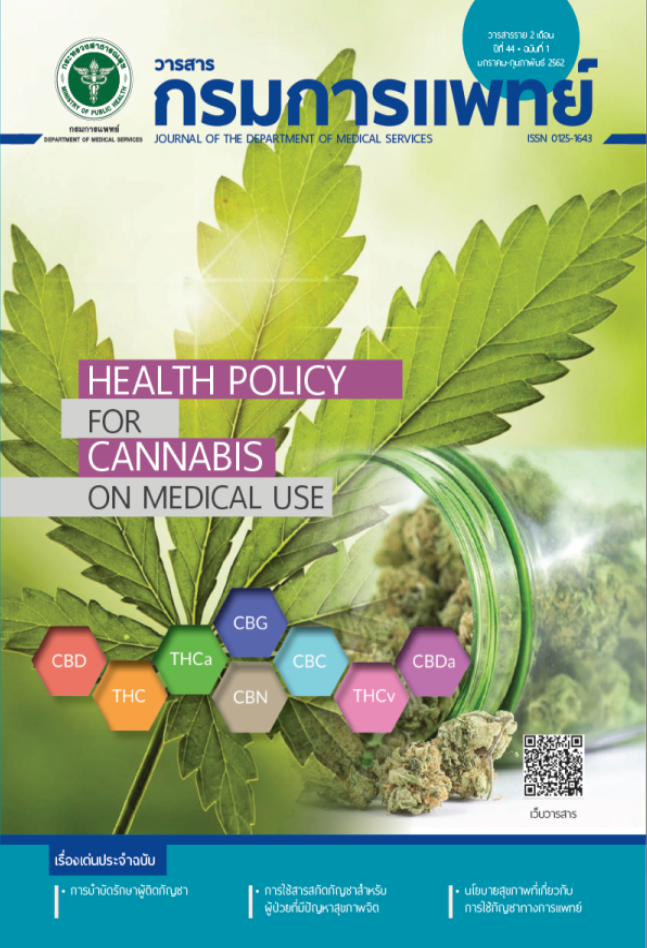อัตราการหยุดสูบบุหรี่ในผู้ที่มีปัญหาการสูบบุหรี่ที่มารับบริการที่โรงพยาบาลบุณฑริก จังหวัดอุบลราชธานี
คำสำคัญ:
อัตราการหยุดสูบบุหรี่, ผู้ที่มีปัญหาการสูบบุหรี่, โรงพยาบาลบุณฑริกจังหวัดอุบลราชธานีบทคัดย่อ
ภูมิหลัง: ผู้มีปัญหาการสูบบุหรี่มารับบริการที่โรงพยาบาลบุณฑริกในปีงบประมาณ 2558-2560 จำนวน 35 54 และ 23 ราย ตามลำดับ หลังเข้ารับบริการมีผู้ที่หยุดบุหรี่ได้ประมาณร้อยละ 25-35 โดยจำนวนของผู้มารับบริการมีค่อนข้างน้อย อัตราการหยุดสูบบุหรี่หลังรับบริการต่ำไม่มีแนวทางการดูแลที่ครอบคลุมทั้งส่งเสริม ป้องกัน บำบัดรักษา และฟื้นฟู รวมถึงไม่มีแนวทางการส่งต่อผู้ที่มีปัญหาการสูบบุหรี่ระหว่างหน่วยงานในโรงพยาบาลและภายนอกโรงพยาบาลที่ชัดเจน ทางผู้วิจัยจึงร่วมกับเจ้าหน้าที่ผู้รับผิดชอบงานสุขภาพจิต จิตเวช และยาเสพติด จัดทำแนวทางการดูแลผู้ที่มีปัญหาการสูบบุหรี่ขึ้น และทำการศึกษาอัตราการหยุดบุหรี่ในผู้ที่มีปัญหาการสูบบุหรี่ที่มารับบริการที่โรงพยาบาลบุณฑริก จังหวัด อุบลราชธานีขึ้น วัตถุประสงค์: เพื่อหาอัตราการหยุดสูบบุหรี่ และปัจจัยที่ส่งผลต่อการหยุดสูบบุหรี่ ในผู้ที่มีปัญหาการสูบบุหรี่ที่มารับบริการที่โรงพยาบาลบุณฑริก จังหวัดอุบลราชธานี วิธีกําร: การศึกษานี้เป็นการศึกษาวิจัยเชิงพรรณนาแบบตัดขวาง (Cross sectional descriptive study) เพื่อเปรียบเทียบอัตราการหยุดสูบบุหรี่ในระยะเวลา 1 เดือน ของผู้ที่มีปัญหาการสูบบุหรี่ที่มารับบริการที่โรงพยาบาลบุณฑริก จังหวัดอุบลราชธานี ก่อนและหลังการใช้แนวทางการดูแลผู้ที่มีปัญหาการสูบบุหรี่ในแผนการจัดบริการสุขภาพอำเภอบุณฑริก จังหวัดอุบลราชธานี ประชากรที่ศึกษา ได้แก่ ผู้ป่วยที่มีอายุ 15 ปีขึ้นไป ที่มารับการรักษาที่โรงพยาบาลบุณฑริก และได้รับการวินิจฉัยโดยแพทย์ตามเกณฑ์วินิจฉัย international classification of diseases (ICD-10) ว่าเป็นผู้ที่สูบบุหรี่แบบผิดแผน (tobacco abuse : F17.1) ผู้ที่ติดบุหรี่ (tobacco dependence : F17.2) ที่ได้รับการคัดกรองด้วยแบบคัดกรอง ASSIST-Thai เพื่อใช้คัดกรองปัญหาการสูบบุหรี่ จำนวน 238 คน และยินดีเข้าร่วมวิจัย ผล: หลังการนำแนวทางมาใช้ในผู้ป่วยจำนวนทั้งสิ้น 238 ราย ส่วนใหญ่เป็นเพศชาย (ร้อยละ 97.9) อายุเฉลี่ย 37.4 ปี (± SD 18.0) ร้อยละ 76.9 เป็นผู้ที่สูบบุหรี่แบบผิดแผน (tobacco abuse : F17.1) ผู้ป่วยที่หยุดบุหรี่ได้มีจำนวน 101 ราย อัตราการหยุดสูบบุหรี่ในผู้ที่มีปัญหาการสูบบุหรี่ที่มารับบริการที่โรงพยาบาลบุณฑริกเพิ่มขึ้นจากร้อยละ 28.6 เป็นร้อยละ 42.4 ปัจจัยที่มีผลต่อการหยุดสูบบุหรี่ คือ 1) การมีอาชีพ (p = 0.02) 2) ปริมาณการสูบบุหรี่ไม่เกิน 10 มวนต่อวัน (p < 0.01) 3) ผู้ที่มีความพยายามในการเลิกสูบบุหรี่ (p < 0.01) 4) การที่เพื่อนหรือคนใกล้ชิดไม่สูบบุหรี่ (p < 0.01) 5) ผู้ที่คะแนน ASSIST-Thai มีระดับความเสี่ยงต่ำ (p < 0.01) 6) ผู้ที่สามารถหยุดสูบบุหรี่หลังได้รับการดูแลตามแนวทางและมาติดตามการรักษาที่ 1 เดือน (p < 0.01) 7) มีแรงจูงใจในการเลิกบุหรี่ (p = 0.02) 8) ความถี่ของความคิดที่คิดจะหยุดสูบบุหรี่มาก (p = 0.01) 9) ผู้ที่ไม่มีความอยากบุหรี่ (p < 0.01) และ 10) ผู้ที่ไม่มีอาการจากการหยุดสูบบุหรี่หรือมีอาการจากการหยุดสูบบุหรี่น้อย (p < 0.01) แต่ผู้ที่มีระยะเวลาหยุดสูบบุหรี่ได้นานสุดไม่เกิน 1 สัปดาห์ มีความสัมพันธ์กับการหยุดสูบบุหรี่ไม่สำเร็จ (p = 0.01) สรุป: อัตราการหยุดสูบบุหรี่ในผู้ที่มีปัญหาการสูบบุหรี่ที่มารับบริการที่โรงพยาบาลบุณฑริก เป็นร้อยละ 42.4 ปัจจัยที่เกี่ยวข้องกับการเพิ่มโอกาสในการหยุดสูบบุหรี่ คือ การส่งเสริมช่วยให้ผู้ป่วยมีระยะเวลาหยุดสูบบุหรี่ได้นานเกิน 1 สัปดาห์ขึ้นไป
เอกสารอ้างอิง
Pittayarangsit S, Pan-krajang P. Statistical report of tobacco consumption in Thailand 2018. Bangkok: Charoendi Mankhongkanphim; 2018.
Watthanawarasan W, Chantothai N, Chitphlichiph S, Tamwong S, Khamnoi P, Phromsut W, et al. The effectiveness of student treatment course who smoke in educational institutions in Chiang Rai province. Chiang Rai: Tobacco control research and knowledge management center (TRC) and Thai health promotion foundation; 2009.
Keesukphan P. smoking cessation [Internet]. mahidol; 2011. Available from:http://med.mahidol.ac.th/fammed/sites/ default/files/public/pdf/smokingcessation.pdf
Nimsakul K. Comparing the Effectiveness of Smoking cessation mouthwash Nicotine gum Varenicline and Nortriptyline in Outpatient service [Internet]. 2016. Available from:http://www.tmh.go.th/ckfinder/userfiles/files/R2R%E 0%B8%9E%E0%B8%B5%E0%B9%88%E0%B8%9F%E0%B8%B2%E0%B8%87.pdf
Pittayarangsit S, Chotibenjamaporn P, Pan-krajang P. Control situation of tobacco consumption in Thailand 2016. Bangkok: Charoendi Mankhongkanphim; 2016.
Thongsiri S. Smoking and Stroke: Greater Risks with Those Who Smoke One. 1. 2013; 43: 296–312.
Kong-To O. Tobacco and (Mental health) Aldolescent [Internet]. Thailand national quitline (TNQ); 2015. Available from: http://www.thailandquitline.or.th/site/news/view/23
Health Data Center - Report [Internet]. [cited 2018 Sep 2]. Available from: https://hdcservice.moph.go.th/hdc/reports/ report.php?source=pop/pop_sex_agemoph.php&cat_id= ac4eed1bddb23d6130746d62d2538fd0&id=f83d0cd8b830706dab4cd3cb09afa584
Data center of Buntharik Hospital. Statistics of patient in Buntharik hospital. Ubon Ratchathani: Buntharik hospital; 2015.
Data center of Buntharik Hospital. Statistics of patient in Buntharik hospital. Ubon Ratchathani: Buntharik hospital; 2016.
Data center of Buntharik Hospital. Statistics of patient in Buntharik hospital. Ubon Ratchathani: Buntharik hospital; 2017.
Rosner B. Fundamentals of biostatistics. Boston: Brooks/ Cole, Cengage Learning; 2011.
Le XTT, To LT, Le HT, Hoang HD, Do KN, Nguyen CT, et al. Factors Associated with Cigarette Smoking and Motivation to Quit among Street Food Sellers in Vietnam. Int J Environ Res Public Health [Internet] 2018. [cited 2019 Feb 11]. Available from: https://www.ncbi.nlm.nih.gov/pmc/articles/ PMC5858292/
Jampaklay A, Siriratsamee B, Siriratsamee T, Genroj P, Pornwiwattanachai S, Konkaew T. The impact of tobacco control policies in Thailand international survey 3rd wave (2008) under International Tobacco Control PolicySoutheast Asia [Internet]. 1st ed. Nakhon Pathom: Institute for Population and Social Research, Mahidol University; 2010. Available from: http://www.ipsr.mahidol.ac.th/ ipsrbeta/FileUpload/PDF/Report-File-375.pdf
Chalongsuk R, Bunditanukul W. Success rates for smoking cessation service by community pharmacist. Thai Bulletin of Pharmaceutical Sciences 2016; 11:17–29.
Chidnayee S, Yottavee W. Factors Related with Smoking Behaviors of Youth at Uttaradit. Boromarajonani College of Nursing, Uttaradit Journal 2018; 10:83–93.
Imnamkhao S. Behavioral Patterns of Smokers at the Smoking Cessation Clinic in Mahasarakham. Journal of Nursing Division 2012; 39:7–20.
Dongpho P, Ua-Kit N. Predicting factors of smoking cessation among patients with coronary artery disease at Thammasat University Hospital. Thammasat Medical Journal 2018; 18:40–50.
Hamadeh RR, Ahmed J, Al-Kawari M, Bucheeri S. Quit tobacco clinics in Bahrain: smoking cessation rates and patient satisfaction. Tobacco Induced Diseases 2017; 15:7.
Bacha ZA, Layoun N, Khayat G, Allit S. Factors associated with smoking cessation success in Lebanon. Pharm Pract (Granada) [Internet]. 2018 [cited 2019 Feb 11]. Available from: https://www.ncbi.nlm.nih.gov/pmc/articles/ PMC5881483/
Lee C, Kahende J. Factors Associated With Successful Smoking Cessation in the United States, 2000. Am J Public Health 2007; 97:1503–9.
Camenga DR, Klein JD. Tobacco Use Disorders. Child Adolesc Psychiatr Clin N Am 2016; 25:445–60.
Ziedonis D, Das S, Larkin C. Tobacco use disorder and treatment: new challenges and opportunities. Dialogues Clin Neurosci. 2017; 19:271–80.
Collins A, Ajayi O, Diamond S, Diamond W, Holroyd S. Tobacco Use and Associated Factors in Patients Presenting to a Psychiatric Emergency Room. Journal of Addiction 2018;1–5.
Joly B, Perriot J, d’Athis P, Chazard E, Brousse G, Quantin C. Success rates in smoking cessation: Psychological preparation plays a critical role and interacts with other factors such as psychoactive substances. PLoS One [Internet]. 2017 [cited 2019 Feb 11]. Available from: https:// www.ncbi.nlm.nih.gov/pmc/articles/PMC5636087/
ดาวน์โหลด
เผยแพร่แล้ว
รูปแบบการอ้างอิง
ฉบับ
ประเภทบทความ
สัญญาอนุญาต
บทความที่ได้รับการตีพิมพ์เป็นลิขสิทธิ์ของกรมการแพทย์ กระทรวงสาธารณสุข
ข้อความและข้อคิดเห็นต่างๆ เป็นของผู้เขียนบทความ ไม่ใช่ความเห็นของกองบรรณาธิการหรือของวารสารกรมการแพทย์



